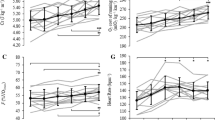Summary
To investigate the different ways of assessing the running velocity at which maximal oxygen uptake\((\dot V{\text{O}}_{{\text{2max}}} )\) occurs, or maximal aerobic velocity (νa max), 32 well-trained runners (8 female and 24 male) were studied. The νa max and the running velocity corresponding to a blood lactate concentration of 4 mmol · l−1 (ν1a4) were measured during a progressive treadmill session. Within the week preceding or following the treadmill measurement the subjects completed a Université de Montreal Track-Test (UMTT). The velocity corresponding to the last stage of this test (νUMTT) was slightly higher than νa max: 6.08m · s−1, SD 0.41, vs 6.01 m · s−1, SD 0.44 (P < 0.03) but these two velocities were strongly correlated (r = 0.92,P < 0.001). The heart rate values corresponding to these velocities were similar and well correlated (r = 0.79,P < 0.01); the corresponding blood lactate values had similar mean values: 10.5 mmol · l−1, SD 2.7 vs 11.8 mmol · l−1, SD 2.5, but were not correlated. Both νa max and νUMTT correlated well with the best performance sustained over 1500 m during the season. These results suggest that the UMTT provides a value of νa max as accurately as a treadmill measurement and that either could be used to measure the running velocity corresponding to\(\dot V{\text{O}}_{{\text{2max}}} .\)
The ν1a4 was 86.6%, SD 2.6 of νa max; these two velocities correlated strongly. Thus, in well trained runners, ν1a4, when measured with a well-defined procedure, corresponds to a constant fraction of νa max and depends then on\(\dot V{\text{O}}_{{\text{2max}}} \) and the energy cost of running.
Similar content being viewed by others
References
Acevedo EO, Goldfarb AH (1989) Increased training intensity effects on plasma lactate, ventilatory threshold, and endurance. Med Sci Sports Exerc 21:563–568
Åstrand P-O (1952) Experimental studies on physical work capacity in relation to sex and age. Munksgaard, Copenhagen
Åstrand P-O, Rodahl K (1986) Textbook of work physiology. Physiological bases of exercise, 3rd edn. McGraw-Hill, New York, p 355
Brue F (1985) Une variante du test progressif et maximal de Léger et Boucher: le test vitesse maximale aérobie derrière cycliste (test VMA). Bull Med Fed Fr Athlet 7:1–18
Davies CTM (1980) Effects of wind assistance and resistance on the forward motion of a runner. J Appl Physiol 48:702–709
Denis C, Dormois D, Castells J, Bonnefoy R, Padilla S, Geyssant A, Lacour JR (1988) Comparison of incremental and steady state tests of endurance training. Eur J Appl Physiol 57:474–481
di Prampero PE (1986) The energy cost of human locomotion on land and in water. Int J Sports Med 7:55–72
di Prampero PE, Atchou G, Brückner JC, Moia C (1986) The energetics of endurance running. Eur J Appl Physiol 55:259–266
Farrell PA, Wilmore JH, Coyle EF, Billing JE, Costill DL (1979) Plasma lactate accumulation and distance running performance. Med Sci Sports 11:338–344
Gaudebout C, Blayo MC (1975) Assessment of Scholander micromethod for gas concentrations versus weighing method. J Appl Physiol 38:546–549
Geyssant A, Dormois D, Barthélémy JC, Lacour JR (1985) Lactate determination with the lactate analyser L.A. 640: a critical study. Scand J Clin Lab Invest 45:145–149
Heck H, Mader A, Hess G, Mücke S, Müller R, Hollmann W (1985) Justification of the 4 mmol/l lactate threshold. Int J Sports Med 6:117–130
Hill AV, Lupton H (1923) Muscular exercise, lactic acid and the supply and utilization of oxygen. Q J Med 16:135–171
Hurley BF, Hagberg JM, Allen WK, Seals DR, Young JC, Cuddihee RW, Holloszy JO (1984) Effect of training on blood lactate levels during submaximal exercise. J Appl Physiol Respir Environ Exerc Physiol 56:1260–1264
Jacobs I (1986) Blood lactate. Implications for training and sports performance. Sports Med 3:10–25
Kindermann W, Simon G, Keul J (1979) The significance of the aerobic-anaerobic transition for the determination of work load intensities during endurance training. Eur J Appl Physiol 42:25–34
Kyle CR (1979) Reduction of wind resistance and power out put of racing cyclists and runners travelling in groups. Ergonomics 22:387–397
Lacour JR, Padilla-Magunacelaya S, Barthélémy JC, Dormois D (1990) The energetics of middle-distance running. Eur J Appl Physiol 60:38–43
Léger L, Boucher R (1980) An indirect continuous running multi-stage field test: the Université de Montreal Track Test. Can J Appl Sports Sci 5:77–84
Medbø JI, Mohn AC, Tabata I, Bahr R, Vaage O, Sejersted OM (1988) Anaerobic capacity determined by maximal accumulated O2 deficit. J Appl Physiol 64:50–60
Morgan DW, Baldini FD, Martin PE, Kohrt WM (1989) Ten kilometer performance and predicted velocity at 82-1O2max among well-trained male runners. Med Sci Sports Exerc 21:78–83
Noakes TD (1988) Implications of exercise testing for prediction of athletic performance: a contemporary perspective. Med Sci Sports Exerc 20:319–330
Sjödin B, Svedenhag J (1985) Applied physiology of marathon running. Sports Med 2:83–99
Sjödin B, Jacobs I, Svedenhag J (1982) Changes in onset of blood lactate accumulation (OBLA) and muscle enzymes after training at OBLA. Eur J Appl Physiol 49:45–57
Svedenhag J, Sjödin B (1984) Maximal and submaximal oxygen uptakes and blood lactate levels in elite male middle- and long distance runners. Int J Sports Med 5:255–261
Tanaka K, Matsuura Y, Matsuzaka A, Hirakoba K, Kumagai S, Sun SO, Asano K (1984) A longitudinal assessment of anaerobic threshold and distance-running performance. Med Sci Sports Exerc 16:278–282
Tanaka K, Takishima N, Kato T, Niihata S, Veda K (1990) Critical determinants of endurance performance in middle-aged and elderly endurance runners with heterogeneous training habits. Eur J Appl Physiol 59:443–449
Williams KR, Cavanagh PR (1987) Relationship between distance running mechanics, running economy and performance. J Appl Physiol 63:1236–1245
Author information
Authors and Affiliations
Rights and permissions
About this article
Cite this article
Lacour, J.R., Padilla-Magunacelaya, S., Chatard, J.C. et al. Assessment of running velocity at maximal oxygen uptake. Europ. J. Appl. Physiol. 62, 77–82 (1991). https://doi.org/10.1007/BF00626760
Accepted:
Issue Date:
DOI: https://doi.org/10.1007/BF00626760




